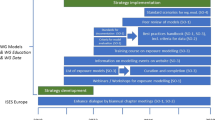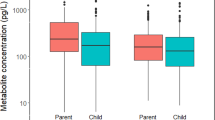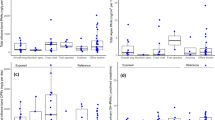Abstract
The GuLF STUDY is a cohort study investigating the health of workers who responded to the Deepwater Horizon oil spill in the Gulf of Mexico in 2010. The objective of this effort was to develop an ordinal job-exposure matrix (JEM) of airborne total hydrocarbons (THC), dispersants, and particulates to estimate study participants’ exposures. Information was collected on participants’ spill-related tasks. A JEM of exposure groups (EGs) was developed from tasks and THC air measurements taken during and after the spill using relevant exposure determinants. THC arithmetic means were developed for the EGs, assigned ordinal values, and linked to the participants using determinants from the questionnaire. Different approaches were taken for combining exposures across EGs. EGs for dispersants and particulates were based on questionnaire responses. Considerable differences in THC exposure levels were found among EGs. Based on the maximum THC level participants experienced across any job held, ∼14% of the subjects were identified in the highest exposure category. Approximately 10% of the cohort was exposed to dispersants or particulates. Considerable exposure differences were found across the various EGs, facilitating investigation of exposure–response relationships. The JEM is flexible to allow for different assumptions about several possibly relevant exposure metrics.
This is a preview of subscription content, access via your institution
Access options
Subscribe to this journal
Receive 6 print issues and online access
$259.00 per year
only $43.17 per issue
Buy this article
- Purchase on Springer Link
- Instant access to full article PDF
Prices may be subject to local taxes which are calculated during checkout

Similar content being viewed by others
References
Laffon B, Pasaro E, Valdiglesias V . Effects of exposure to oil spills on human health: updated review. J Toxicol Environ Health B Crit Rev 2016; 19: 1–24.
Kwok RK, Engel LS, Miller AK, Blair A, Curry MD, Jackson WB et alThe GuLF STUDY: a prospective study of persons involved in the Deepwater Horizon oil spill response and clean-up. Environ Health Perspect 2017; 125: 570–578.
NIOSH (National Institute for Occupational Safety and Health). 2016. Pocket Guide to Chemical Hazards. Available at http://www.cdc.gov/niosh/docs/2003-154/method-2000.html. accessed 19 May 2016.
On Scene Coordinator Report Deepwater Horizon Oil Spill. Submitted to the National Response Team September 2011. Available at http://www.uscg.mil/foia/docs/dwh/fosc_dwh_report.pdf(accessed 9 February 2015.)
Aguilera F, Mendez J, Pasaro E, Laffon B. Review on the effects of exposure to spilled oils on human health. J App Toxicol 2010; 30: 291–301.
Huynh T, Ramachandran G, Banerjee S, Monteiro J, Stenzel M, Sandler DP et al. Comparison of methods for analyzing left- censored occupational exposure data. Ann Occup Hyg 2014; 58: 1–17.
Huynh T, Quick H, Ramachandran G, Banerjee S, Stenzel M, Sandler DP et al. A comparison of the β-substitution method and a Bayesian method for analyzing left-censored data. Ann Occup Hyg 2016; 60: 56–73.
NALCO www.nalcoenvironmentalsolutionsllc.com/wp-content/uploads/COREXIT-EC9500A-GHS-SDS-USA.pdf.and http://www.nalcoesllc.com/nes/documents/MSDS/NESLLC-COREXIT-_EC9527A-March_2012.pdf.accessed 16 August 2016.
OSAT-2 2011 Summary report for fate and effects of remnant oil in the beach environment. Annex C: Weathering and depletion of oil. Available at www.nalcoenvironmentalsolutionsllc.com/wp-content/uploads/COREXITM-EC9527A-GHS-SDS-USA.pdf(accessed 28 May 2016)
Blair A, Stewart PA . Correlation between different measures of occupational exposure to formaldehyde. Am J Epidemiol 1990; 131: 510–516.
Campbell D, Cox D, Crum J, Foster K, Christie P, Brewster D . Initial effects of the grounding of the tanker Braer on health in Shetland. The Shetland Health Study Group. Brit Med J 1993; 307: 1251–1255.
Morita A, Kusaka Y, Deguchi Y, Moriuchi A, Nakanaga Y, Iki M et al. Acute health problems among the people engaged in the cleanup of the Nakhodka oil spill. Environ Res 1999; 81: 185–194.
Perez-Cadahia B, Laffon B, Pasaro E, Mendez J . Genetic damage induced by accidental environmental pollutants. Sci World J 2006; 6: 1221–1237.
Gorman RW, Berardinelli SP, Bender TR, Exxon Valdez Alaska Oil Spill, HETA 89-200 & 89-273-2111. May 1991. National Institute for Occupational Safety and Health.
Acknowledgements
We express our appreciation for the invaluable support and feedback of the GuLF STUDY Scientific Advisory Board and the Exposure Assessment Working Group. We also thank Wendy McDowell and Caitlin Roush of McDowell Safety and Health Services, LLC and GuLF STUDY staff at Social & Scientific Systems, Inc who assisted with programming and analysis for this effort. This study was funded by the NIH Common Fund and the Intramural Research Program of the NIH, National Institute of Environmental Health Sciences (ZO1 ES 102945).
Author information
Authors and Affiliations
Corresponding author
Ethics declarations
Competing interests
The authors declare no conflict of interest.
Additional information
Supplementary Information accompanies the paper on the Journal of Exposure Science and Environmental Epidemiology website
Rights and permissions
About this article
Cite this article
Stewart, P., Stenzel, M., Ramachandran, G. et al. Development of a total hydrocarbon ordinal job-exposure matrix for workers responding to the Deepwater Horizon disaster: The GuLF STUDY. J Expo Sci Environ Epidemiol 28, 223–230 (2018). https://doi.org/10.1038/jes.2017.16
Received:
Accepted:
Published:
Issue Date:
DOI: https://doi.org/10.1038/jes.2017.16
Keywords
This article is cited by
-
Nontraditional Occupational Exposures to Crude Oil Combustion Disasters and Respiratory Disease Risk: A Narrative Review of Literature
Current Allergy and Asthma Reports (2023)
-
Trans-ancestry epigenome-wide association meta-analysis of DNA methylation with lifetime cannabis use
Molecular Psychiatry (2023)
-
Natural hazards and mental health among US Gulf Coast residents
Journal of Exposure Science & Environmental Epidemiology (2021)
-
Developing Large-Scale Research in Response to an Oil Spill Disaster: a Case Study
Current Environmental Health Reports (2019)
-
Deepwater Horizon oil spill exposures and nonfatal myocardial infarction in the GuLF STUDY
Environmental Health (2018)



